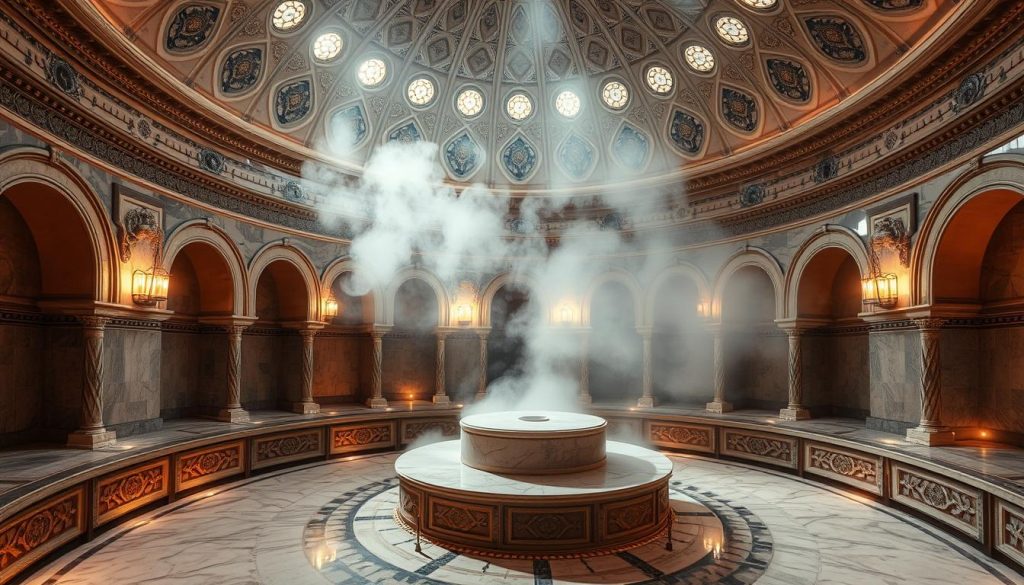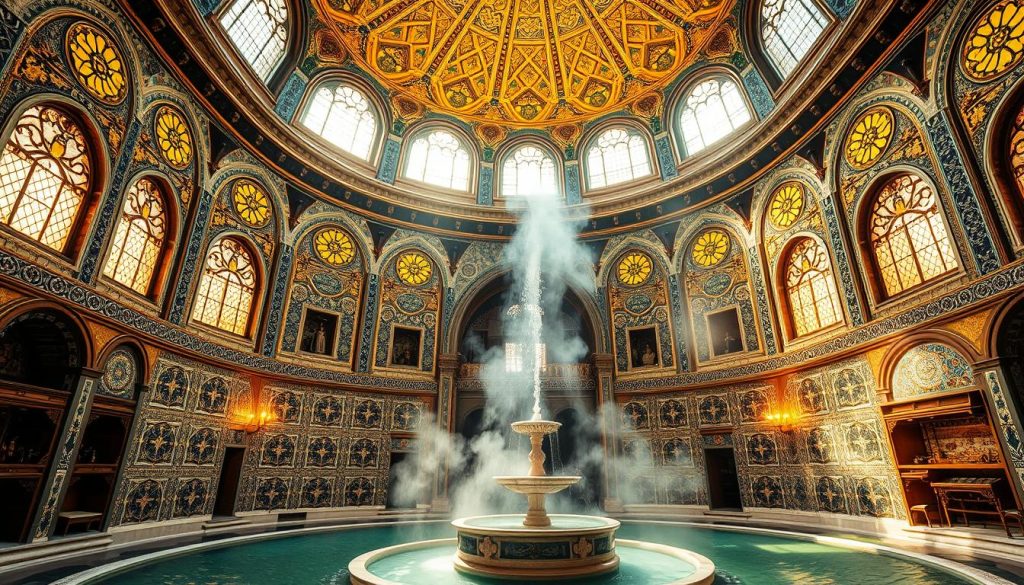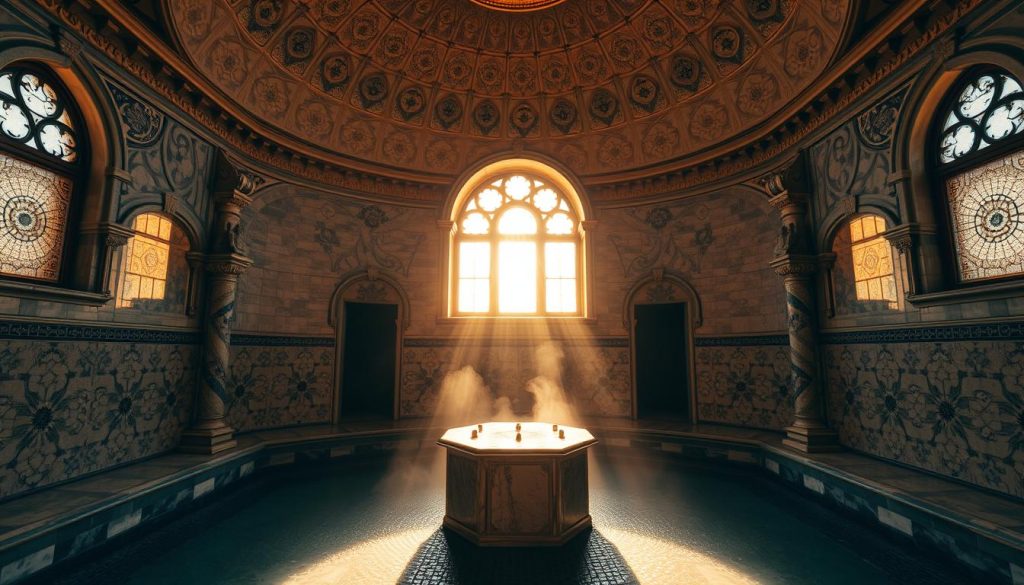Have you ever stepped into a space where time seems to pause? Where centuries-old marble hums with warmth beneath your feet, and fragrant steam carries whispers of Ottoman sultans? This isn’t just a bathhouse—it’s a portal to wellness traditions that have soothed generations. For over 400 years, Istanbul’s hamams have offered more than cleansing: they’ve been sanctuaries where bodies heal, minds unwind, and history breathes.
Picture the Çemberlitaş Hamamı, crafted in 1584 by legendary architect Mimar Sinan. Commissioned by Sultan Murad III’s mother, its domed ceilings and intricate stonework still cradle visitors today. Here, every massage and steam session connects you to rituals perfected through empires. You’re not just relaxing—you’re tracing fingertips along the same heated marble where poets and traders once found solace.
What makes these spaces unforgettable? It’s the harmony of design and purpose. Sinan’s genius flows through clever water systems and domes that trap healing vapors. Modern spas might offer luxury, but can they match the weight of history in a traditional Turkish bath? As you explore Istanbul’s hammams, you’ll discover why these rituals endure: they don’t just cleanse skin—they renew spirits.
Key Takeaways
- Istanbul’s hamams blend centuries-old wellness rituals with stunning Ottoman architecture
- Master builders like Mimar Sinan designed therapeutic spaces still used today
- These baths served as community hubs for all social classes since the 1500s
- Traditional techniques use heat, steam, and massage for deep rejuvenation
- Modern updates preserve heritage while adding contemporary comforts
- A hamam visit offers cultural immersion beyond typical tourist experiences
Introduction: A Fusion of History and Relaxation
Where can you unwind like a sultan and soak in centuries of tradition? Istanbul’s bathhouses blend architectural marvels with rituals that shaped empires. These spaces aren’t relics—they’re living chapters of a story written in steam and marble.
Embracing Istanbul’s Rich Cultural Legacy
Walk into a 15th-century hamam, and you’ll find more than baths. Polished marble floors once trodden by merchants now welcome modern travelers. The domed ceilings, designed by Ottoman architects, create natural acoustics that amplify the gentle splash of water.
These spaces served as community hubs. Families celebrated weddings here. Traders negotiated deals between steam sessions. Even sultans visited public baths, sharing the same heated platforms as locals. This democratic approach to wellness remains central to the cultural experience today.
Why Turkish Baths Continue to Captivate You
The secret lies in timeless design meeting modern needs. Traditional techniques like the classic Turkish massage pair perfectly with today’s desire for authentic escapes. Below, see how historic features align with contemporary wellness:
| Historic Element | Modern Benefit |
|---|---|
| Marble heated platforms | Deep muscle relaxation |
| Domed steam chambers | Natural detoxification |
| Communal washing rituals | Social bonding opportunities |
You’re not just booking a spa day—you’re joining a 500-year-old tradition that continues to redefine renewal. From the Ottoman Empire to today’s travelers, these baths prove great design never goes out of style.
Historical Foundations of Turkish Bath Culture
Step into a world where marble meets legacy, and every stone whispers tales of communal wellness. Istanbul’s bathhouses didn’t just clean bodies—they shaped societies. For centuries, these spaces blended spiritual rituals with vibrant social exchanges, creating a blueprint for holistic living.
Origins in the Ottoman Empire
Ottoman rulers transformed bathing into an art form. During their 16th-century reign, they commissioned grand hamams as symbols of civic pride. These weren’t mere buildings—they were social equalizers where merchants and ministers shared heated platforms. Architects designed gender-separated areas and advanced heating systems, innovations still praised in detailed hamam catalogues.
The Evolution of Hamam Traditions
What began as Roman-inspired steam rooms became cultural hubs. By the 1700s, hamams hosted wedding preparations and trade deals. Today’s visitors experience this legacy firsthand—scrub sessions echo ancient purification rites, while massages blend Ottoman techniques with modern comfort. As one bath attendant remarked: “Our hands remember what our ancestors taught.”
Three pillars sustained these traditions:
- Community focus: Birthdays, business talks, and bridal rituals unfolded under domed ceilings
- Architectural genius: Vaulted chambers trapped healing steam naturally
- Cultural fusion: Byzantine mosaics met Islamic geometric patterns
This living history makes a Turkish bath experience more than skincare—it’s time travel through touch and tradition.
Exploring Classic Turkish Bath Experiences
What does a 500-year-old wellness ritual feel like against your skin? Your journey begins in a marble chamber filled with 45°C steam, where every breath draws centuries of tradition into your lungs. This isn’t merely bathing—it’s a cultural awakening choreographed across three transformative stages.

Traditional Rituals and Time-Honored Practices
First comes the steam embrace. As warmth penetrates your muscles, pores open like Ottoman-era aqueducts channeling purity. Skilled attendants then perform the kese scrub, wielding coarse mitts to whisk away dead cells. Your skin emerges silkier than Sultan’s robes.
Next arrives the foam massage—a spectacle where olive oil soap transforms into clouds. Bubbles cascade over you, their lightness contrasting with the vigorous exfoliation. Each motion follows patterns perfected through generations, creating harmony between intensity and comfort.
The Role of Ancient Architectural Designs
Look upward as steam curls against domed ceilings. These architectural marvels trap heat while creating natural acoustics—every droplet’s echo becomes part of your experience. The göbek taşı (central platform) warms your body as it once did for Silk Road traders.
Strategic water basins and marble surfaces aren’t decorations. They’re functional masterpieces ensuring optimal humidity and temperature control. Modern spas imitate these features, but none replicate the weight of history pressing gently against your back.
Relaxation Intertwined with History: The Magical Journey of Massage in Istanbul
Imagine lying on warm marble as skilled hands blend ancient techniques with aromatic foam. This is where history becomes tangible through touch. Traditional Turkish baths transform simple cleansing into art, using methods perfected over 500 years.
The ritual begins with olive oil soap whipped into clouds of delicate foam. Centuries-old methods create this luxurious lather, softening skin while preparing muscles for therapy. As one attendant notes: “Our foam carries memories of grandmothers’ recipes.”
What follows redefines relaxation. Practitioners perform rhythmic motions across heated stone, combining:
| Component | Benefit |
|---|---|
| Heated marble surfaces | Deep tissue warmth |
| Olive oil soap foam | Skin exfoliation |
| Expert hand techniques | Improved circulation |
These elements work synergistically. Your tension dissolves as thermal energy enhances the foam massage’s effects. Modern studies confirm what Ottoman healers knew – heat amplifies touch therapy’s benefits.
You’re not just receiving treatment. You’re participating in living heritage. The same spaces that hosted sultans now offer rejuvenating experiences to global visitors. Each kneading motion connects you to generations seeking balance through tactile wisdom.
This fusion of past and present creates unmatched therapeutic value. While modern spas focus on luxury, traditional Turkish baths deliver transformation through time-tested practices. Your body rediscovers vitality where empires once renewed theirs.
The Timeless Beauty of Mimar Sinan’s Creations
What does true architectural genius feel like beneath your fingertips? At Çemberlitaş Hamamı, your palms meet marble shaped by renowned architect Mimar Sinan in 1584. Commissioned by Sultan Murad III’s mother, this masterpiece blends Ottoman grandeur with therapeutic precision.

Iconic Structures Like Çemberlitaş Hamamı
Your eyes lift naturally to the 38-foot dome, where 120 star-shaped windows paint light patterns on ancient stone. Sinan’s design creates perfect acoustics – water droplets echo like whispered secrets from 16th-century attendants. The central heating system still warms marble slabs exactly as it did for Silk Road merchants.
Architectural Mastery and Cultural Significance
You’ll discover three revolutionary features in every massage session here:
- Thermal engineering: Underground channels maintain ideal steam temperatures
- Sacred geometry: Dome proportions mirror Ottoman spiritual concepts
- Community design: Separate sections enabled social bonding across classes
This authentic Turkish bath experience lets you touch history literally. As Sinan himself noted: “Stones breathe when shaped by purpose.” Four centuries later, his vision still elevates wellness into art.
Sensory Journey: Steam, Foam, and Massage
What happens when centuries-old wellness rituals awaken your senses? The hararet (hot room) becomes your gateway to multi-layered rejuvenation. Here, every element works in harmony to create an experience that transcends ordinary spa treatments.
Immersing in the Warmth of the Steam Room
Your journey begins on the göbektaşı—a heated marble platform at the room’s heart. For 15 minutes, aromatic steam works its magic. Pores open like ancient aqueducts as your body releases toxins naturally. The dome above traps warmth while basins along the walls maintain perfect humidity.
This solitary preparation phase isn’t just about sweating. It’s a biological reset—your muscles soften, skin breathes, and mind unwinds. As one attendant explains:
“The marble remembers how to heal. You just need to let it.”
Experiencing the Unique Foam Massage
Next comes the showstopper. Olive oil soap transforms into billowing clouds that blanket your body. Skilled hands work through the suds, blending rhythmic pressure with playful lightness. This 2-minute spectacle does more than cleanse—it stimulates circulation while leaving skin impossibly soft.
| Element | Therapeutic Benefit |
|---|---|
| Olive Oil Soap | Deep skin nourishment |
| Marble Surface | Retains healing warmth |
| Expert Technique | Boosts blood flow |
Modern spas can’t replicate this synergy. The foam’s texture, the steam’s embrace, and centuries-honed skills create what regular massages lack—transformative power. As bubbles dissolve tension, you’ll understand why this essential Turkish bath experience remains unmatched.
Modern Luxuries Meet Traditional Turkish Baths
How do centuries-old wellness rituals stay relevant today? Istanbul’s updated hamams answer through smart evolution. While marble slabs and steam chambers remain unchanged, new enhancements deepen your experience without breaking tradition’s spell.
Enhanced Treatments With Fresh Perspectives
Your session might begin with detoxifying Rhassoul clay masks – a Moroccan touch that amplifies Ottoman scrubs. Later, therapists might blend Indian Ayurvedic techniques with aromatic oils during massage sequences. These contemporary treatments work alongside classic foam rituals, creating layered results for modern skin needs.
Luxury extends beyond therapy rooms. Upscale facilities now feature:
- Hydrotherapy pools that complement thermal baths
- Private jacuzzis overlooking historic districts
- Post-treatment lounges with organic refreshments
You’ll leave with more than relaxed muscles. Many premier spa experiences include gift bags filled with hamam-grade soaps and colognes. These thoughtful touches let you extend the luxurious Turkish bath atmosphere into daily life.
This balance honors heritage while embracing today’s wellness standards. As one manager notes: “We guard our ancestors’ wisdom but welcome new ways to delight guests.” Your visit becomes both cultural immersion and cutting-edge pampering – a rare combination only Istanbul delivers.






